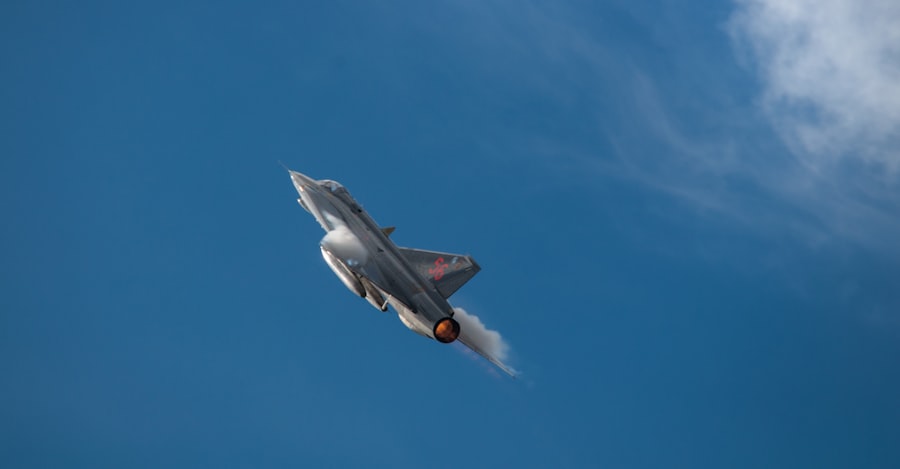Jet aircraft efficiency is a critical aspect of modern aviation, influencing not only operational costs but also environmental impact. As air travel continues to grow, the demand for more efficient aircraft has become paramount. Efficiency in this context encompasses various factors, including fuel consumption, maintenance costs, and overall performance.
The aviation industry is under increasing pressure to reduce its carbon footprint while maintaining safety and reliability. This dual challenge has spurred innovations across multiple domains, from engineering to operational practices. The efficiency of jet aircraft can be measured in several ways, including fuel burn per passenger mile, the weight-to-thrust ratio, and the overall lifecycle costs of the aircraft.
As airlines strive to optimize their fleets, understanding these metrics becomes essential. The interplay between technological advancements and regulatory pressures shapes the landscape of jet aircraft efficiency, making it a dynamic field that evolves with new discoveries and societal demands. The quest for efficiency is not merely a matter of economics; it also reflects a broader commitment to sustainability and responsible stewardship of the planet’s resources.
Key Takeaways
- Jet aircraft efficiency is crucial for reducing fuel consumption and environmental impact
- Advancements in technology have led to more efficient jet aircraft designs and operations
- Sustainable fuel options, such as biofuels, are being developed to reduce the carbon footprint of jet aircraft
- Aerodynamic design plays a key role in improving the efficiency of jet aircraft
- Engine efficiency improvements, including the use of advanced materials and designs, are essential for reducing fuel consumption and emissions
Advancements in Jet Aircraft Technology
The evolution of jet aircraft technology has been marked by significant milestones that have dramatically improved efficiency. One of the most notable advancements is the development of composite materials, which have replaced traditional metals in many aircraft structures. Composites are lighter and stronger, allowing for reduced weight without compromising safety or performance.
This reduction in weight directly translates to lower fuel consumption, as lighter aircraft require less thrust to achieve flight. Moreover, advancements in avionics have revolutionized how pilots interact with their aircraft. Modern jet aircraft are equipped with sophisticated flight management systems that optimize flight paths in real-time, taking into account weather conditions, air traffic, and fuel efficiency.
These systems enable pilots to make informed decisions that enhance operational efficiency. For instance, the implementation of Continuous Descent Approaches (CDA) allows aircraft to descend gradually rather than in a series of steps, reducing fuel burn and noise pollution during landing.
Sustainable Fuel Options for Jet Aircraft

As the aviation industry grapples with its environmental impact, sustainable fuel options have emerged as a focal point for enhancing jet aircraft efficiency. Traditional jet fuels are derived from fossil sources, contributing significantly to greenhouse gas emissions. In response, researchers and companies are exploring alternative fuels such as biofuels, synthetic fuels, and hydrogen.
Biofuels, derived from organic materials like plant oils and agricultural waste, can reduce lifecycle carbon emissions by up to 80% compared to conventional jet fuels. Synthetic fuels, produced through chemical processes that convert carbon dioxide and hydrogen into hydrocarbons, offer another promising avenue. These fuels can be designed to be compatible with existing jet engines and infrastructure, facilitating a smoother transition for airlines.
Hydrogen fuel cells represent a more radical shift; they produce zero emissions at the point of use and can potentially power future generations of aircraft. However, the widespread adoption of hydrogen as a fuel source faces challenges related to storage, distribution, and infrastructure development.
Aerodynamic Design and Efficiency
| Aspect | Metric | Value |
|---|---|---|
| Aerodynamic Efficiency | Drag Coefficient | 0.25 |
| Aerodynamic Design | Frontal Area | 2.0 m^2 |
| Aerodynamic Performance | Lift-to-Drag Ratio | 20:1 |
Aerodynamics plays a pivotal role in determining the efficiency of jet aircraft. The shape of an aircraft influences its drag coefficient, which directly affects fuel consumption during flight. Innovations in aerodynamic design have led to the development of winglets—small vertical extensions at the tips of wings that reduce vortex drag.
By minimizing drag, winglets can improve fuel efficiency by as much as 5%, making them a common feature on modern commercial jets. Additionally, advancements in computational fluid dynamics (CFD) have enabled engineers to simulate airflow over aircraft surfaces with unprecedented accuracy. This technology allows for iterative design processes that refine shapes and structures before physical prototypes are built.
The Boeing 787 Dreamliner is an excellent example of how aerodynamic optimization can lead to significant improvements in efficiency; its sleek design and advanced wing structure contribute to a 20% reduction in fuel consumption compared to earlier models.
Improvements in Engine Efficiency
The heart of any jet aircraft lies in its engines, and advancements in engine technology have been instrumental in enhancing overall efficiency. Modern turbofan engines are designed with higher bypass ratios, meaning that a larger volume of air is bypassed around the engine core rather than passing through it. This design not only improves thrust but also reduces specific fuel consumption significantly.
For instance, engines like the Pratt & Whitney GTF (Geared Turbofan) utilize a unique gear system that allows the fan to operate at optimal speeds independently from the engine core, resulting in improved efficiency and reduced noise levels. Furthermore, materials science has played a crucial role in engine development. The introduction of advanced ceramic matrix composites (CMCs) allows engines to operate at higher temperatures without compromising structural integrity.
Higher operating temperatures lead to improved thermal efficiency, which translates into better fuel economy. The combination of these technological advancements has led to engines that are not only more efficient but also more reliable and easier to maintain.
The Role of Automation in Jet Aircraft Efficiency

Automation has transformed various aspects of aviation, particularly in enhancing the efficiency of jet aircraft operations. Advanced autopilot systems can manage flight paths with precision, optimizing altitude and speed for fuel savings throughout the journey. These systems can also integrate with air traffic control data to adjust routes dynamically based on real-time conditions, further enhancing operational efficiency.
Moreover, automation extends beyond flight operations into maintenance practices. Predictive maintenance technologies utilize data analytics and machine learning algorithms to anticipate potential issues before they become critical failures. By analyzing data from various sensors embedded within the aircraft systems, airlines can schedule maintenance proactively rather than reactively.
This approach minimizes downtime and ensures that aircraft remain in optimal flying condition, ultimately contributing to overall efficiency.
Maximizing Passenger Comfort and Efficiency
While efficiency is often viewed through the lens of operational metrics, passenger comfort is an equally important consideration that can influence overall satisfaction and airline profitability. Modern jet aircraft are designed with passenger experience in mind; features such as improved cabin pressurization systems enhance comfort during long flights by reducing fatigue and discomfort associated with altitude changes. Additionally, airlines are increasingly focusing on cabin layout and design to maximize space without compromising comfort.
Innovations such as slimmer seat designs and adjustable lighting contribute to a more pleasant flying experience while allowing airlines to increase capacity without significantly increasing weight or operational costs. The balance between maximizing passenger comfort and maintaining operational efficiency is delicate but essential for airlines aiming to attract and retain customers.
The Future of Jet Aircraft Efficiency: Challenges and Opportunities
Looking ahead, the future of jet aircraft efficiency presents both challenges and opportunities as the industry navigates an evolving landscape shaped by technological advancements and regulatory pressures. One significant challenge lies in the need for substantial investment in research and development for sustainable aviation technologies. While promising innovations exist, scaling these solutions for widespread adoption requires collaboration among manufacturers, airlines, governments, and research institutions.
Moreover, regulatory frameworks will play a crucial role in shaping the future of jet aircraft efficiency. Governments worldwide are increasingly implementing stringent emissions targets that compel airlines to adopt greener technologies more rapidly than ever before. This regulatory environment can drive innovation but may also pose challenges for smaller airlines that may struggle to keep pace with larger competitors.
On the horizon are opportunities for breakthroughs in electric propulsion systems and hybrid technologies that could redefine how we think about air travel. As battery technology continues to advance, electric-powered regional jets may become viable within the next few decades, offering a zero-emission alternative for short-haul flights. The integration of artificial intelligence into flight operations could further optimize routes and reduce fuel consumption.
In conclusion, while the path toward greater jet aircraft efficiency is fraught with challenges, it is also rich with potential for innovation and improvement across multiple dimensions of aviation technology and operations. The ongoing commitment to enhancing efficiency will not only benefit airlines economically but will also contribute significantly to reducing the environmental impact of air travel as we move toward a more sustainable future.


